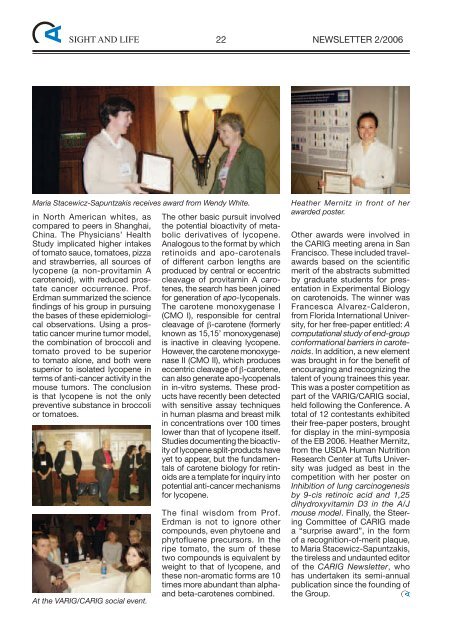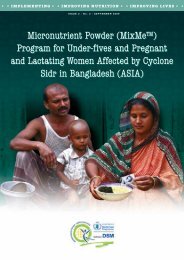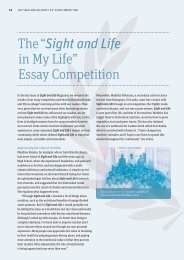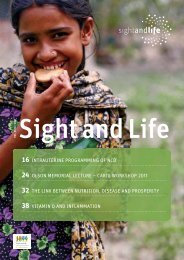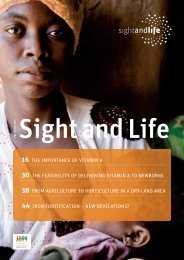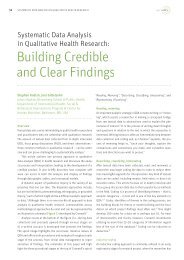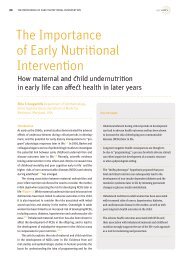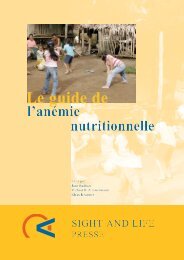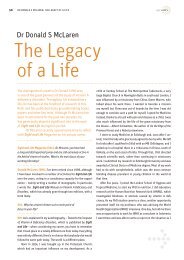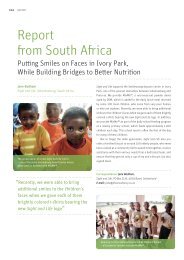Newsletter 02 2006.pdf - Sight and Life
Newsletter 02 2006.pdf - Sight and Life
Newsletter 02 2006.pdf - Sight and Life
Create successful ePaper yourself
Turn your PDF publications into a flip-book with our unique Google optimized e-Paper software.
SIGHT AND LIFE 22<br />
NEWSLETTER 2/2006<br />
Maria Stacewicz-Sapuntzakis receives award from Wendy White.<br />
in North American whites, as<br />
compared to peers in Shanghai,<br />
China. The Physicians’ Health<br />
Study implicated higher intakes<br />
of tomato sauce, tomatoes, pizza<br />
<strong>and</strong> strawberries, all sources of<br />
lycopene (a non-provitamin A<br />
carotenoid), with reduced prostate<br />
cancer occurrence. Prof.<br />
Erdman summarized the science<br />
findings of his group in pursuing<br />
the bases of these epidemiological<br />
observations. Using a prostatic<br />
cancer murine tumor model,<br />
the combination of broccoli <strong>and</strong><br />
tomato proved to be superior<br />
to tomato alone, <strong>and</strong> both were<br />
superior to isolated lycopene in<br />
terms of anti-cancer activity in the<br />
mouse tumors. The conclusion<br />
is that lycopene is not the only<br />
preventive substance in broccoli<br />
or tomatoes.<br />
At the VARIG/CARIG social event.<br />
The other basic pursuit involved<br />
the potential bioactivity of metabolic<br />
derivatives of lycopene.<br />
Analogous to the format by which<br />
retinoids <strong>and</strong> apo-carotenals<br />
of different carbon lengths are<br />
produced by central or eccentric<br />
cleavage of provitamin A carotenes,<br />
the search has been joined<br />
for generation of apo-lycopenals.<br />
The carotene monoxygenase I<br />
(CMO I), responsible for central<br />
cleavage of β-carotene (formerly<br />
known as 15,15’ monoxygenase)<br />
is inactive in cleaving lycopene.<br />
However, the carotene monoxygenase<br />
II (CMO II), which produces<br />
eccentric cleavage of β-carotene,<br />
can also generate apo-lycopenals<br />
in in-vitro systems. These products<br />
have recently been detected<br />
with sensitive assay techniques<br />
in human plasma <strong>and</strong> breast milk<br />
in concentrations over 100 times<br />
lower than that of lycopene itself.<br />
Studies documenting the bioactivity<br />
of lycopene split-products have<br />
yet to appear, but the fundamentals<br />
of carotene biology for retinoids<br />
are a template for inquiry into<br />
potential anti-cancer mechanisms<br />
for lycopene.<br />
The final wisdom from Prof.<br />
Erdman is not to ignore other<br />
compounds, even phytoene <strong>and</strong><br />
phytofluene precursors. In the<br />
ripe tomato, the sum of these<br />
two compounds is equivalent by<br />
weight to that of lycopene, <strong>and</strong><br />
these non-aromatic forms are 10<br />
times more abundant than alpha<strong>and</strong><br />
beta-carotenes combined.<br />
Heather Mernitz in front of her<br />
awarded poster.<br />
Other awards were involved in<br />
the CARIG meeting arena in San<br />
Francisco. These included travelawards<br />
based on the scientific<br />
merit of the abstracts submitted<br />
by graduate students for presentation<br />
in Experimental Biology<br />
on carotenoids. The winner was<br />
Francesca Alvarez-Calderon,<br />
from Florida International University,<br />
for her free-paper entitled: A<br />
computational study of end-group<br />
conformational barriers in carotenoids.<br />
In addition, a new element<br />
was brought in for the benefit of<br />
encouraging <strong>and</strong> recognizing the<br />
talent of young trainees this year.<br />
This was a poster competition as<br />
part of the VARIG/CARIG social,<br />
held following the Conference. A<br />
total of 12 contestants exhibited<br />
their free-paper posters, brought<br />
for display in the mini-symposia<br />
of the EB 2006. Heather Mernitz,<br />
from the USDA Human Nutrition<br />
Research Center at Tufts University<br />
was judged as best in the<br />
competition with her poster on<br />
Inhibition of lung carcinogenesis<br />
by 9-cis retinoic acid <strong>and</strong> 1,25<br />
dihydroxyvitamin D3 in the A/J<br />
mouse model. Finally, the Steering<br />
Committee of CARIG made<br />
a “surprise award”, in the form<br />
of a recognition-of-merit plaque,<br />
to Maria Stacewicz-Sapuntzakis,<br />
the tireless <strong>and</strong> undaunted editor<br />
of the CARIG <strong>Newsletter</strong>, who<br />
has undertaken its semi-annual<br />
publication since the founding of<br />
the Group.


